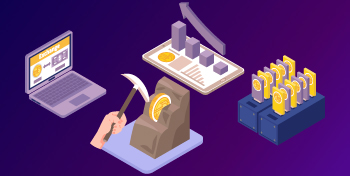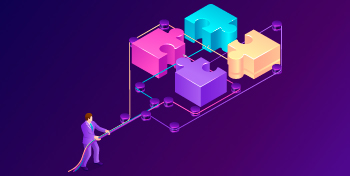Currently, Blockchain developers are highly sought after. Learning the best programming languages for blockchain development will definitely give you an advantage over other developers.
One of the most sought-after industries
According to market research estimates, the market volume of blockchain technology will increase significantly in the next five years. Between 2020 and 2025, the size of the global blockchain market is expected to grow at a rate of 67.3% CAGR to reach 39.7 billion in 2025, from US$3.0 billion in 2020.
One can reasonably assume that this growth will drive innovation and also require scaling up existing platforms. In both cases, the developers would have to play the most important role. Although some of the existing languages will be used continuously, some innovations will require knowledge of new ones.
In general, developers and enthusiasts of blockchain should be mindful of the advantages and disadvantages of programming algorithms. This will help them choose the most appropriate language – the most appropriate for their needs.
Here, in this article, we will look at the best blockchain programming languages and discuss their qualities.
C ++
C++ offers a wide variety of features and capabilities that meet the typical requirements of blockchain development. Some of its most commonly used functions include move semantics, primitive memory control, advanced multithreading, function overloading, runtime polymorphism, etc.. These functions prove their effectiveness in combining data and functions into one module.
Aside from these features, C++ also offers efficient CPU management and excellent memory control. In a C++ environment, it is easy to run parallel or non-parallel threads. It also allows you to isolate code for different data structures.
This is the language in which blockchain was first implemented. Some of the leading cryptocurrency platforms using it include Bitcoin, Litecoin, Ripple, Stellar and EOS.
Java
Java is often regarded as the most popular language in blockchain development, being official for developing applications on Android. Java is also considered a great choice for backend development projects. It offers an extensive API or application programming interface that includes a wide range of classes, packages and interfaces. Using Java, you can create an application without knowing completely about their intrinsic meaning.
When it comes to programming on the blockchain, one of the most important features of Java is its compatibility. This means that it is portable to a wide range of platforms due to WORA functionality. WORA implies “write once, run anywhere”. Because Java uses a universal Java virtual machine or JVM to execute, its programs are independent of the system architecture. Some other benefits include support for object-oriented programming, ease of memory cleaning, and having enough libraries. Blockchain solutions using it include NEM, IOTA, etc.
C #
C# is syntactically similar to Java and C++, so it’s ideal for Blockchain programming. Although C# was originally created only as a Microsoft tool, it is now quite popular and is considered one of the best for blockchain. Open source developers can easily create very portable code using C# that will run on all devices and on multiple operating systems such as Windows, Linux, Mac, Android, etc. D.
Also, since C# is an OOP programming language, Blockchain developers can get maximum performance when developing the next blockchain. Projects written in C# include Stratis, a Blockchain as a service provider that allows businesses to easily create applications on these platforms.
Solidity
Solidity was developed by Ethereum co-founder Vitalik Buterin. It was inspired by JavaScript, C++ and Powershell. Many experts believe this is the first language any potential blockchain developer should learn. Solidity has gained popularity as being most suitable for developing decentralized applications or DApps. It is also important to know, suddenly you decide to develop ICO.
Solidity is extremely user-friendly. While it is itself a separate language, it can access Javascript infrastructures, debuggers, and other necessary tools. It has provisions for statistically typed programming. Solidity also supports forked and legacy Ethereum projects. Overall he is known for its accuracy and accuracy.
Python
Python is fast becoming a strong contender for the position of the most preferred programming language. Although it is interpretable, many developers choose Python because of its ability to allow rapid prototyping of their ideas, without having to write verbose codes. It is an object-oriented language that helps to effectively manage performance overhead. The self-help resources that help work with Python are abundantly available online.
For new developers, Python is an easy-to-learn tool. It allows you to access a dynamic architecture with open source support and is ideal for both the basic approach and scripting. Some of the popular blockchain projects developed in Python include Hyperledger Fabric, Steem, and many others.
Golang
Golang commonly known as Go, is very complex. It is believed to be the best language for creating a hypertext book structure. The Hyper ledger structure serves as the foundation on which blockchain programs are developed. It’s a statistically typed and compilable programming language. Golang also offers many performance features, including universal templates, classes and inheritance, constructors, annotations, exceptions, etc.
In terms of convenience, its use combines the best capabilities of JavaScript and Python. It is user-friendly, scalable, flexible and offers great speed. These features make Golang an ideal option for creating custom blockchain solutions. Given all these features, it’s no surprise that Golang employs more than 800,000 developers on the network.
Simplicity
Simplicity is a high-level programming language. Both professional programmers and open source developers use Simplicity to write smart contracts. Being high-level, it also proves useful in reducing the low-level and complex understanding of the Bitcoin scenario. This feature helps crypt developers improve their performance and, in turn, speed up the development period. Simplicity also goes well with an open source blockchain platform called Elements. Developers who use Elements to develop sidechains also use several features and features of Simplicity.
As a language, Simplicity uses a syntax similar to Haskell and is based on IVY. By its nature it is mathematical, and lines of code can be read by people who don’t know it. Simplicity was developed by Russell O’Connor and was introduced to the market in November 2017. Although it was a novelty, it gained significant momentum in this area due to its compatibility with Bitcoin and Ethereum virtual machines.
Haskell
As a programming language, Haskell is used in blockchains such as Cardano because of its advanced security features. Haskell protects memory from unintended changes. This means that no one can accidentally change any value in memory that is not intended to be modified. This also prevents junk data from entering memory and makes it impossible for a remote attack or remote execution of code by an attacker. In neml, it is also impossible to send the wrong code until the code is fixed.
Haskell offers features that prevent code from interacting with the outside world. If a programmer points out that the code he wrote is not designed to interact with the outside world, he won’t. This feature reduces the amount of code that would otherwise have to be checked against malicious input. Using Haskell also helps simplify the testing process and ensure quality.
Kotlin
The well-known open-source blockchain platform Corda uses Kotlin. Kotlin is developed by JetBrains. It targets JVM and JavaScript. This language is preferable to others like Scala and Caylon because it provides almost seamless interaction with Java. Kotlin classes offer regular Java APIs with get/set/is methods that do not require any special annotation or effort. Kotlin also helps eliminate the overhead associated with heavy use of higher-order functions and allows them to control the flow within the Lambda function.
Kotlin codes are very similar to Java. Other languages like Quasar and Scada don’t have that capability. Kotlin is also easy to explore thanks to proper documentation and a standard library of suitable size. It has better support for IntelliJ, the most popular IDE, as well as coping well with problems pertaining to libraries, SQL DSL and IDE/Tooling. Overall, Kotlin provides excellent customer support, and has managed to receive a high level of positive feedback since its launch.
Vyper

Vyper is a new Blockchain programming language derived from Python 3. Thus, Vyper syntax is also a valid Python 3 syntax, although it does not possess all of its functions. Vyper is created as an alternative to Solidity. It is usually used for the Ethereum VM (EVM), as is Solidity. However, Vyper has other control structures, and it also addresses security concerns differently.
Vyper also abandoned many OOPS features in Solidity along with other features such as infinite loops, modifiers, recursive call, and more. This helps to avoid the security issues that arise because of them. So if you need a Blockchain development language to write smart contracts, try Vyper.
The conclusion
Have you ever wondered about the sudden emergence and popularity of blockchain? What is that? Well, Blockchain is literally a chain of blocks, as the name suggests. Just “blocks” in this context are digital information related to the use of cryptography. Each of these blocks contains a cryptographic hash function linking to the previous block, a timestamp, and digital information in the block. These blocks are structured in such a way that it is very difficult to change data, and so they provide transparency while maintaining security at the same time. Blockchain is actually synonymous with security as interference with these blocks is almost impossible. And it makes this technology very popular in such areas as banking, finance, etc. In fact, Blockchain first became popular when it was used when implementing Bitsoin. After all, people want their money to be as reliable as possible. And it depends on the language of blockchain development of the project. So – dash, study and develop.


